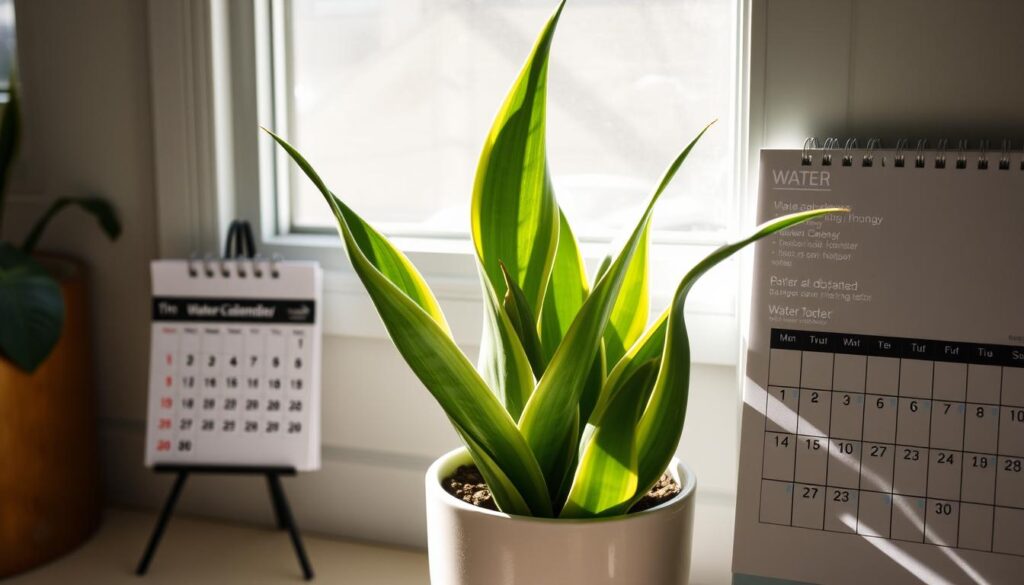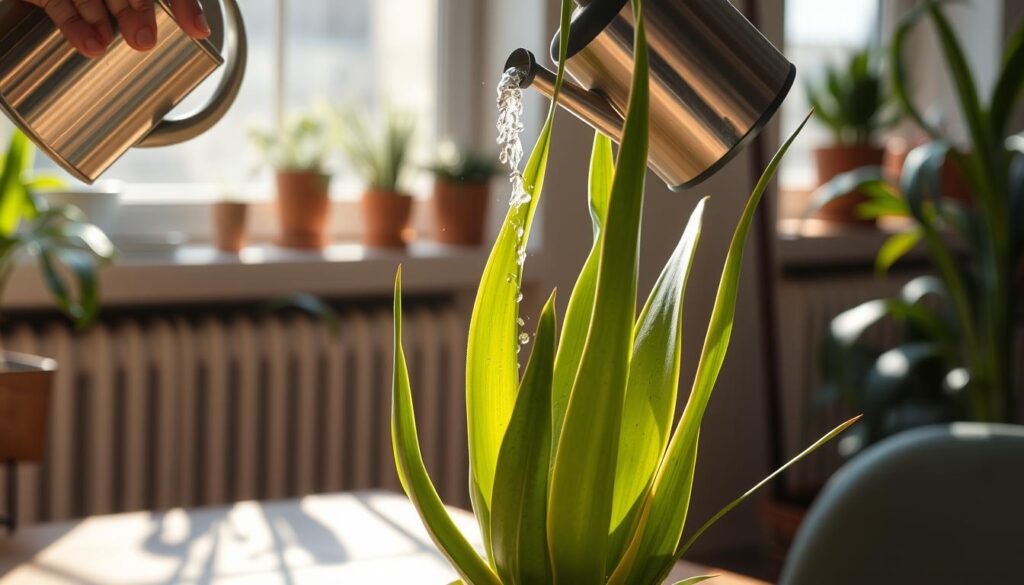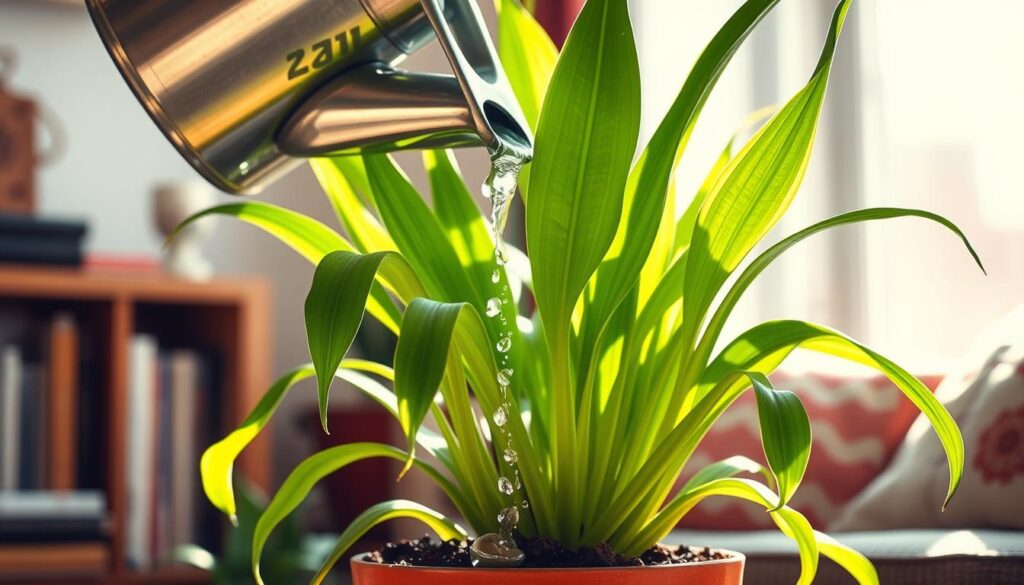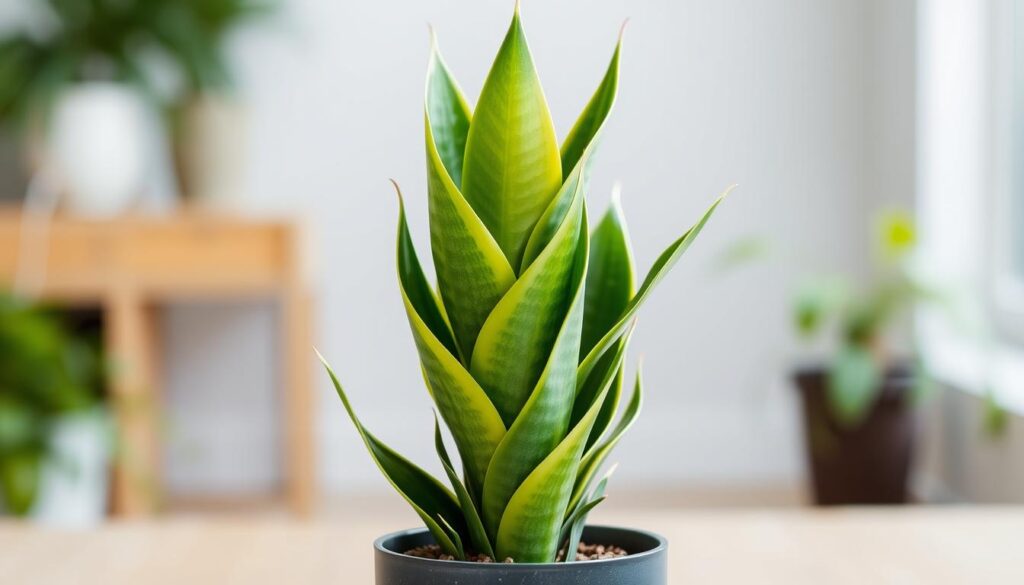The snake plant is known for being easy to care for. But finding the right watering balance can be tricky. In this article I will show you the best watering schedule for snake plants. This will help keep your plant healthy and thriving.
Snake plants also known as Sansevieria are known for their toughness. They can do well in many conditions. Whether you are new to plants or have experience knowing their water needs is key to their success.
Understanding Snake Plant Basics and Water Requirements
Snake plants are fascinating but their water needs can be confusing. To grasp their watering needs let us look at where they come from and how they grow naturally.
Native Habitat and Natural Growing Conditions
Snake plants also known as mother in laws tongue come from Africas dry lands. They grow well in dry rocky soil and get little rain. This helps us understand how much water they need.
Why Snake Plants Are Drought Tolerant
Snake plants can go without water for a long time. Their thick leaves store water, keeping them moist. This skill shows how well they’ve adapted to dry places.
Basic Water Storage Mechanisms
Snake plants have special cells called succulent cells. These cells hold water for the plant to use when it’s dry. This system makes snake plants easy to care for.
Knowing where snake plants come from and how they store water helps us water them right. This knowledge ensures our drought-tolerant plants get the care they need. By following a succulent plant care guide, we can help these plants do well indoors.
How Often Water Snake Plant: A Complete Watering Schedule
Keeping your snake plant (Sansevieria) watered right is key to its health. These plants are known for being easy to care for. But, they still need water to grow well.
The amount of water your snake plant needs depends on a few things. This includes the size of the pot, the soil type, and the environment. Generally, water your snake plant every 2-3 weeks in spring and summer. In fall and winter, you can water it every 4-6 weeks.
To find the best watering schedule for your snake plant, think about a few things:
- Pot Size: Bigger pots need more water because the soil takes longer to dry.
- Soil Type: Sandy soil dries out faster than heavy soil, so it needs more water.
- Environmental Conditions: Plants in sunny, warm, and dry places need more water than those in cooler, wetter spots.
Check the soil moisture and adjust your watering schedule as needed. This way, your snake plant will get just the right amount of water. It’s important to avoid too much or too little water.
| Pot Size | Soil Type | Environmental Conditions | Watering Frequency |
|---|---|---|---|
| Small | Well-draining | Bright, warm, dry | Every 2-3 weeks (growing season) Every 4-6 weeks (dormant season) |
| Large | Dense, heavy | Cool, humid | Every 3-4 weeks (growing season) Every 6-8 weeks (dormant season) |

By following this detailed watering guide, you can make sure your snake plant gets the right moisture. This will help it thrive and grow for many years.
Signs Your Snake Plant Needs Water
As a devoted plant parent, it’s important to watch your snake plant closely. Knowing when it’s thirsty helps prevent problems. Let’s look at how to tell if your snake plant needs water.
Visual Indicators of Thirst
One clear sign is how the leaves look. If your snake plant is dehydrated, you might see:
- Leaves curling or folding inward, showing a loss of turgor pressure.
- Leaves becoming wrinkled or shriveled, losing their usual firmness.
- Leaf tips and edges turning brown or yellow, a sign of moisture loss.
Soil Moisture Testing Methods
Checking the soil moisture is also key. Use a soil moisture meter or stick your finger in the soil. Water when the top 2-3 inches feel dry.
Leaf Texture Changes
Notice how your snake plants leaves feel. Healthy leaves are firm and rigid. As they get thirsty, they’ll feel softer and more pliable. This is a clear sign it’s time to water.
By watching for these signs, you can keep your snake plant healthy. Regular checks and timely watering are crucial for its well-being.

Avoiding Common Snake Plant Watering Mistakes
As a devoted snake plant enthusiast, I’ve learned that proper watering is key. Even experienced gardeners can make mistakes. Let’s look at how to avoid these and keep your snake plant healthy.
One big mistake is overwatering. Snake plants are drought-tolerant but can get root rot from too much water. It’s important to check the soil moisture and only water when it’s dry.
- Stick your finger into the soil up to the second knuckle – if it feels damp, hold off on watering.
- Use a soil moisture meter to accurately gauge the soil’s moisture content.
- Avoid watering on a strict schedule, as environmental factors can affect your snake plant’s water needs.
Poor drainage is another issue. Make sure your plant is in well-draining soil and the pot has holes for water to drain. This prevents waterlogged soil and root rot.
| Common Snake Plant Watering Mistakes | Solutions |
|---|---|
| Overwatering | Check soil moisture before watering, use a moisture meter, and water only when the soil is completely dry. |
| Poor drainage | Use a well-draining soil mix and ensure the container has adequate drainage holes. |
By avoiding these mistakes, you’ll give your succulent plant care and snake plant care guide the best watering. This will help your plant grow well and stay healthy.
Seasonal Adjustments for Snake Plant Watering
As seasons change, so do your snake plant’s watering needs. It’s important to understand these changes to keep your plant healthy all year. Let’s look at how summer and winter, indoor climate, and humidity affect your plant’s watering.
Summer vs Winter Watering Needs
In summer, snake plants need more water because they grow faster. Check the soil every 7-10 days. Water when the top inch or two feels dry. In winter, they need less water since they grow slower. I water mine once a month or every 6-8 weeks then.
Impact of Indoor Climate Control
Indoor climate control systems can dry out the soil faster. This means you might need to water more often. I watch my plant’s soil closely and adjust watering as needed to keep it healthy.
Humidity Considerations
Humidity also affects how often you should water your snake plant. Dry air means you’ll need to water more. But in humid air, you can water less. I check my plant’s leaves and soil to find the right watering schedule for my home’s humidity.
FAQ
How often should I water my snake plant?
Watering your snake plant depends on a few things. Generally, water it every 2-3 weeks in spring and summer. In winter, you can water every 4-6 weeks.
What are the native habitat and natural growing conditions of snake plants?
Snake plants come from tropical Africa and Asia. They love well-drained soil and can go without water for a long time. This makes them great for indoor spaces.
Why are snake plants considered drought-tolerant?
Snake plants store water in their leaves. This lets them survive without water for a while. It’s why they’re easy to care for indoors.
How do I determine the ideal watering schedule for my snake plant?
The right watering time for your snake plant depends on a few things. Wait until the soil is almost dry before watering again. This means watering every 2-3 weeks in spring and summer, and every 4-6 weeks in winter.
What are the visual signs that my snake plant needs water?
Look for signs that your snake plant needs water. If leaves are wrinkled or dull, it’s time to water. Also, check if the soil is dry and cracked.
How can I avoid overwatering my snake plant?
To avoid overwatering, use a potting mix that drains well. Make sure your pot has holes for water to drain. Let the soil dry out between waterings, especially in cooler months.
Do I need to adjust my snake plant’s watering routine based on the season?
Yes, adjust your watering based on the season. Water more often in summer when the plant is growing. In winter, water less to avoid root rot.


